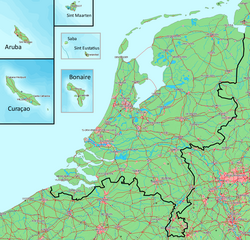Kingdom of the Netherlands | |
|---|---|
| Motto: "Je maintiendrai" (French)[a] (English: "I will uphold")[b] | |
| Anthem: "Wilhelmus" (Dutch) (English: "William of Nassau") | |
 | |
 Map of the four constituent countries shown to scale | |
| Capital and largest city | Amsterdam[c] 52°22′N 4°53′E / 52.367°N 4.883°E |
| Government seat | The Hague[c] |
| Official languages | Dutch[d] |
| Official regional languages[d] | |
| Recognised languages[d] | |
| Demonym(s) | Dutch |
| Countries (non‑sovereign parts) | |
| Government | Devolved unitary parliamentary constitutional monarchy |
• Monarch | Willem-Alexander |
| Dick Schoof | |
| Guillfred Besaril | |
| Carlson Manuel[8] | |
| Rene Violenus[9] | |
| Independence | |
| 26 July 1581 (declared) 30 January 1648 (recognised) | |
| 19 January 1795 | |
| 5 June 1806 | |
• Annexation by First French Empire | 1 July 1810 |
| 16 March 1815 | |
• Secession of Belgium | 4 October 1830 (declared) 19 April 1839 (recognised) |
| 15 December 1954 | |
| Area | |
• Total | 42,531[10] km2 (16,421 sq mi) (131st) |
• Water (%) | 18.96 |
| Population | |
• 2023 estimate | |
• Density | 532/km2 (1,377.9/sq mi) |
| Currency | 4 currencies
|
| Time zone | European Netherlands: CET (UTC+1) CEST (UTC+2) (DST) Caribbean Netherlands: AST (UTC-4) DST not observed |
| Date format | dd-mm-yyyy |
| Drives on | right |
| Calling code | |
| ISO 3166 code | NL |
| Internet TLD | |
The Kingdom of the Netherlands (Dutch: Koninkrijk der Nederlanden, pronounced [ˈkoːnɪŋkrɛiɡ dɛr ˈneːdərlɑndə(n)] ;[h], West Frisian: Keninkryk fan Nederlân, Papiamento: Reino Hulandes), commonly known simply as the Netherlands,[i] is a sovereign state consisting of a collection of constituent territories united under the monarch of the Netherlands, who functions as head of state. The realm is not a federation; it is a unitary monarchy with its largest subdivision, the eponymous Netherlands, predominantly located in Northwestern Europe and with several smaller island territories located in the Caribbean.
The four subdivisions of the Kingdom—Aruba, Curaçao, the Netherlands, and Sint Maarten—are constituent countries (landen in Dutch; singular: land) and participate on a basis of equality as partners in the Kingdom.[12] In practice, however, most of the Kingdom's affairs are administered by the Netherlands—which comprises roughly 98% of the Kingdom's land area and population—on behalf of the entire Kingdom. Consequently, Aruba, Curaçao, and Sint Maarten are dependent on the Netherlands for matters like foreign policy and defence, but are autonomous to a certain degree, with their own parliaments.
The vast majority of land area of the constituent country of the Netherlands is in Europe, while its three special municipalities (Bonaire, Saba, and Sint Eustatius) are located in the Caribbean, as are the other three constituent countries. The Kingdom has a population in the Netherlands of 17,821,419 (as of January 2023[update]),[11] and of 29,418 (as of November 2023[update]) in Bonaire, Saba, and Sint Eustatius.[13]
Cite error: There are <ref group=lower-alpha> tags or {{efn}} templates on this page, but the references will not show without a {{reflist|group=lower-alpha}} template or {{notelist}} template (see the help page).
- ^ a b "LANDSVERORDENING van de 28ste maart 2007 houdende vaststelling van de officiële talen (Landsverordening officiële talen)" (in Dutch). Government of the Netherlands. 10 October 2010. Archived from the original on 10 September 2019. Retrieved 30 July 2013.
- ^ According to Art. 1 para 2. Constitution of Sint Maarten Archived 25 March 2016 at the Wayback Machine: "The official languages are Dutch and English"
- ^ a b "Invoeringswet openbare lichamen Bonaire, Sint Eustatius en Saba" (in Dutch). wetten.nl. Archived from the original on 21 December 2017. Retrieved 27 December 2017.
- ^ Migge, Bettina; Léglise, Isabelle; Bartens, Angela (2010). Creoles in Education: An Appraisal of Current Programs and Projects. Amsterdam: John Benjamins Publishing Company. p. 268. ISBN 978-90-272-5258-6. Archived from the original on 1 January 2021. Retrieved 26 October 2020.
- ^ "Wet gebruik Friese taal" (in Dutch). wetten.nl. Archived from the original on 27 December 2017. Retrieved 27 December 2017.
- ^ "Welke erkende talen heeft Nederland?" (in Dutch). Rijksoverheid. 11 January 2016. Archived from the original on 27 December 2017. Retrieved 29 December 2018.
- ^ "Besluit van 24 juni 2021 tot vaststelling van het tijdstip van inwerkingtreding van de Wet erkenning Nederlandse Gebarentaal" (PDF). Staatsblad van het Koninkrijk der Nederlanden. 2021. ISSN 0920-2064. Archived (PDF) from the original on 3 July 2021. Retrieved 1 July 2021.
- ^ Vordev. "Carlson Manuel becomes the new Minister Plenipotentiary for Curaçao in The Hague". www.curacaochronicle.com. Retrieved 23 July 2023.
- ^ Emmanuel requests letter Violenus read to Dutch govt, SMN News, 30 December 2020
- ^ "Oppervlakte". Archived from the original on 13 January 2020. Retrieved 10 January 2020.
- ^ a b "CBS Statline". opendata.cbs.nl (in Dutch). Retrieved 30 March 2023.
- ^ The Charter of the Kingdom was fully explained in an "EXPLANATORY MEMORANDUM to the Charter for the Kingdom of the Netherlands", transmitted to the United Nations Secretary-General in compliance with the wishes expressed in General Assembly resolutions 222 (III) and 747 (VIII). New York, 30 March 1955 (* Ministerie van Buitenlandse Zaken, 41, Suriname en de Nederlandse Antillen in de Verenigde Naties III, Staatsdrukkerij-en uitgeversbedrijf/ 's Gravenhage, 1956)
- ^ "CBS Statline". opendata.cbs.nl (in Dutch). Retrieved 28 November 2023.

